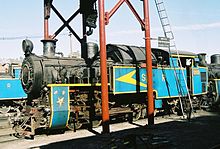Nilgiri Mountain Railway X class
| Nilgiri Mountain Railway X class | |||||||||||||||||||||||
|---|---|---|---|---|---|---|---|---|---|---|---|---|---|---|---|---|---|---|---|---|---|---|---|
 Nilgiri Mountain Railway locomotive No.37385, preserved at the Delhi Railway Museum | |||||||||||||||||||||||
| |||||||||||||||||||||||
| |||||||||||||||||||||||
| |||||||||||||||||||||||
The X class is a metre gauge 0-8-2T rack and pinion compound locomotive used by the Nilgiri Mountain Railway in the Nilgiri Hills of southern India. They are used on the 28-kilometre-long (17 mi) section between Coonoor and Mettupalayam, where the steepest gradient is 1 in 12.5. The railway uses the Abt system on these steep sections. The locomotives have two high-pressure and two low-pressure cylinders, located outside the locomotive's frames. The low-pressure cylinders drive the rack gears, and are positioned above the two main high-pressure cylinders which drive the main wheels.
This class of engine was acquired to replace the line's original Beyer, Peacock & Company 2-4-0T rack locomotives, which were not powerful enough to handle the traffic.[1][2] The X-class locomotives were bought in two batches from the Swiss Locomotive & Machine Works, Winterthur, Switzerland. The first batch of 12 was delivered between 1914 and 1925, and the second batch of five was delivered in 1952.[1][3] Four more members of the class were built in India between 2011 and 2014.
SLM orders[]
| SLM Works Nos. | Year | Quantity | NMR No. | All India No. | Notes |
|---|---|---|---|---|---|
| 2456–2459, 2469–2470 | 1914 | 6 | 1–6 | 37379–37384 | ex-No. 1-6, 37379-37383 (1-5) scrapped off during the British Raj |
| 2734–2736, 2733 | 1920 | 4 | 7–10 | 37385–37388 | |
| 3000–3001 | 1925 | 2 | 11–12 | 37389–37390 | |
| 4069–4073 | 1952 | 5 | 13–17 | 37391–37395 | |
| n/a | 2011 - 2014 | 4 | 18–21 | 37396–37399 | Non-SLM, All Oil-powered, 37397-37399 (19-21) rebuilt by G.O.C. in 2018, 2019 and 2020 with modern loco pilot cabs |
| n/a | 2020 - 2021 | 2 | 22–23 | 37400–37401 | Non-SLM, Not Yet Rolled Out, One Coal-powered and Another Oil-powered (Source:- Deccan Herald) |
Conversion to oil[]

The coal-fired Locomotive No. 37395 was modified to oil firing in 2002, and another locomotive was similarly modified shortly afterwards. The railway intends to convert more locomotives to oil-fired system, since they are less likely to spark forest fires and are easier to refuel. Unlike coal-fired engines which require two firemen, only one fireman needs to travel with the driver of an oil-fired locomotive.[6][7]
New locomotives[]
To ease the load on existing X-class locomotives, four oil-fired X-Class 0-8-2T rack and pinion compound engine steam locomotives with a similar design were ordered. The first one (No. X 37396) arrived in February 2011 and entered service on March 24 of that year. The second one (X 37397), named "Betta Queen" was rolled out at the Golden Rock Railway Workshop in February 2012, and entered service on the railway in March. The third one built by Golden Rock, Trichy (X 37398), named "Nilgiri Queen", entered service in March 2013. The fourth (X 37399), named "Nilgiri Flycatcher" was rolled out on March 5, 2014 at the Central Workshop in Ponmalai, Tiruchirapalli, to join the fleet after trials on the railway.
In 2020, under Central Govt's order, Ponmalai Goldenrock (G.O.C.) started manufacture of one coal-powered and one oil-powered X-Class Steam Engine, But due to COVID-19, lockdown etc, could not finish and roll out on time (Source:- Deccan Herald)
In fiction[]
Ashima, a character based on the X Class and voiced by Tina Desai, appears in the 2016 animated film Thomas & Friends: The Great Race. She also appears in the twenty-second series, the twenty-third series and the twenty-fourth series of Thomas & Friends. [8][9][10]
In Bollywood[]
The X-class Steam Engines were temporarily repainted and used in the song Chayya Chayya, featuring Shah Rukh Khan and Malaika Arora dancing on the Train, from the 1998 Mani Ratnam movie Dil Se. For shooting the song, Mani Ratnam spoke to NMR for painting the X-class Steam Engines in Greenish Black Color and the Train Rakes in Brick Color, for 5 days, as the shooting took 108 hours (4.5 days).
References[]
Notes[]
- ^ a b Bhandari, R. R. (2008). "Steam in history". IRFCA. Retrieved 2 March 2010.
- ^ "Blue Mountain Railway". India for Visitors. indiaforvisitors.com. 2003. Retrieved 2 March 2010.
- ^ "National Railway Museum". Rail in India. Retrieved 2 March 2010.
- ^ Hughes 1992, p. 98
- ^ Hughes 1996, p. 58
- ^ Rajaram, R. (21 December 2009). "Work for manufacturing four new oil-fired steam locos begins". The Hindu. Chennai, India. Archived from the original on 31 December 2009.
- ^ "Oil fired Steam engine on Nilagiri Railway , India". Encyclopedia.com. HighBeam. 2009. Retrieved 2 March 2010.
- ^ "Meet Ashima, and Her Impact on Child Product Sales to India". India Briefing. March 31, 2016. Archived from the original on December 7, 2016. Retrieved July 13, 2017.
- ^ "Ashima - Character Profile & Bio". Thomas & Friends - Official Website. Retrieved August 26, 2017.
- ^ "Flying Scotsman on track to star in new 'more diverse' Thomas the Tank Engine film". ITV News. April 6, 2016. Archived from the original on August 11, 2016. Retrieved July 13, 2017.
Bibliography[]
- Hughes, Hugh (1992). Indian Locomotives, Part 2 – Metre Gauge 1872–1940. Harrow, Middlesex: Continental Railway Circle. ISBN 978-0-9503469-9-1.
- Hughes, Hugh (1996). Indian Locomotives, Part 4 – 1941–1990. Harrow, Middlesex: Continental Railway Circle. ISBN 978-0-9521655-1-4.
External links[]
![]() Media related to Nilgiri Mountain Railway class X at Wikimedia Commons
Media related to Nilgiri Mountain Railway class X at Wikimedia Commons
- Steam locomotives of India
- Compound locomotives
- 0-8-2T locomotives
- SLM locomotives
- Rack and cog driven locomotives
- Metre gauge steam locomotives
- Passenger locomotives
- Railway locomotives introduced in 1914